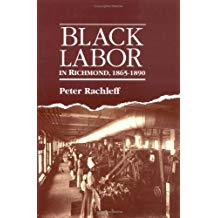While the focus of Peter Rachleff’s Black Labor in Richmond is, obviously, on black labor, the book crosses race lines to unfold postbellum interactions of class, race, and labor in the former capitol of the Confederacy.
The ground, ante-bellum Richmond, was distinct from the Deep South/Cotton States, as well as from the North, for its intermingled labor community of hired-out slaves, black freemen, and white men “native born” and immigrant, any one of whom could be skilled or manual. Black and white workers competed and cooperated with each other, but rivalries took place within race; for example, whites often aligned with German, Irish, Scottish, Welsh, and other ethnic loyalties.
Post-bellum, blacks and whites continued to compete and cooperate in a labor market often capitalized by Northern investors. Sometimes blacks and white came together; sometimes they used each other for leverage, all in common cause for getting decent wages and working conditions from the Big Business of the day.
Just as in the present day United States….
Rachleff’s microcosm of Richmond’s granite industry during what was a golden age for building in stone is fascinating. Granite was strongly unionized, with communication among granite workers fostered up and down the quarries of the Atlantic seaboard. This cooperation allowed, for example, black and white granite workers to come together, in 1886, and win concessions from Richmond Granite Company.
Black Labor in Richmond captures not only the macrocosmic, lumpy melting pot of workers in the US, it also traces the rise of unionism, and how the concerns of workers could unite diverse, and often hostile, groups.
Black Labor in Richmond, by Peter J. Rachleff. Chicago: University of Illinois Press, 1989.
